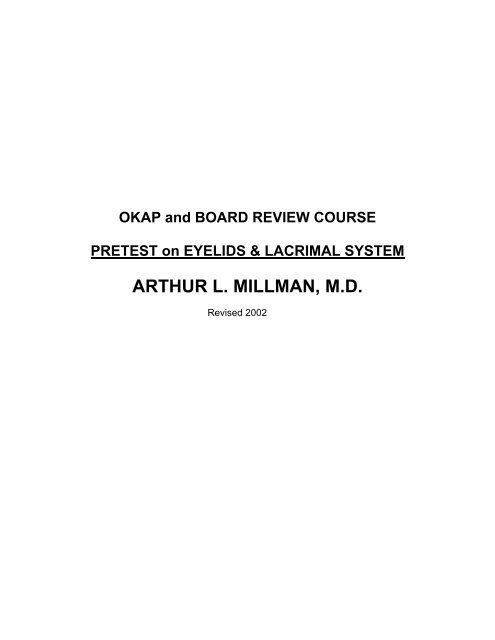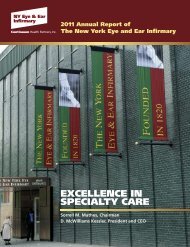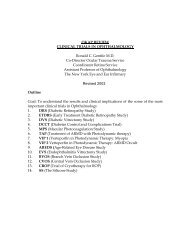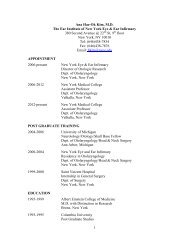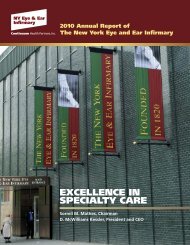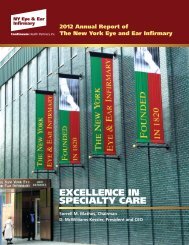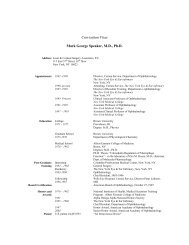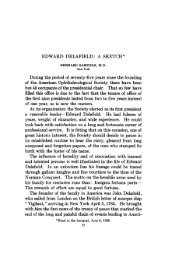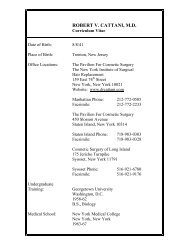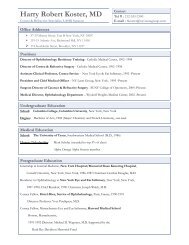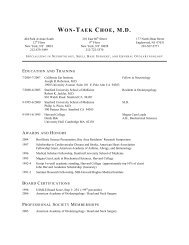OKAP and BOARD REVIEW COURSE PRETEST on EYELIDS ...
OKAP and BOARD REVIEW COURSE PRETEST on EYELIDS ...
OKAP and BOARD REVIEW COURSE PRETEST on EYELIDS ...
You also want an ePaper? Increase the reach of your titles
YUMPU automatically turns print PDFs into web optimized ePapers that Google loves.
<str<strong>on</strong>g>OKAP</str<strong>on</strong>g> <str<strong>on</strong>g>and</str<strong>on</strong>g> <str<strong>on</strong>g>BOARD</str<strong>on</strong>g> <str<strong>on</strong>g>REVIEW</str<strong>on</strong>g> <str<strong>on</strong>g>COURSE</str<strong>on</strong>g><br />
<str<strong>on</strong>g>PRETEST</str<strong>on</strong>g> <strong>on</strong> <strong>EYELIDS</strong> & LACRIMAL SYSTEM<br />
ARTHUR L. MILLMAN, M.D.
Directi<strong>on</strong>s: Each of the questi<strong>on</strong>s or incomplete statements below is followed by five suggested<br />
answers or completi<strong>on</strong>s. Select the <strong>on</strong>e that is BEST in each case.<br />
1. The nasolacrimal duct opens into the<br />
A. superior meatus of the nose<br />
B. middle meatus of the nose<br />
C. inferior meatus of the nose<br />
D. 50% of the time into the middle meatus, 50% of the time into the inferior meatus<br />
E. 50% of the time into the superior meatus, 50% of the time into the middle meatus<br />
REF: 8 – pp. 230-232<br />
2. How many millimeters medial to the medial canthus is the angular vein situated?<br />
A. 1 mm<br />
B. 2 mm<br />
C. 4 mm<br />
D. 8 mm<br />
E. 10-12 mm<br />
REF: 8 – p. 414<br />
3. The layers traversed in cutting through the eyelid 15 mm above the upper last line are<br />
A. skin, orbicularis, tarsus, c<strong>on</strong>junctiva<br />
B. skin, orbicularis, orbital septum, Muller’s muscle, levator, c<strong>on</strong>junctiva<br />
C. skin, orbicularis, orbital septum, fat, levator, Muller’s muscle, c<strong>on</strong>junctiva<br />
D. skin, orbicularis, levator, orbital septum, Muller’s muscle, c<strong>on</strong>junctiva<br />
E. skin, orbicularis, levator, Muller’s muscle, c<strong>on</strong>junctiva<br />
REF: 8 – pp. 175-176<br />
4. All the following are true about Muller’s muscle EXCEPT that it<br />
A. arises from the inferior aspect of the levator palpebrae behind the plane of the<br />
posterior pole of the globe<br />
B. inserts into the superior tarsal plate<br />
C. is sympathetically innervated<br />
D. gives off a superolateral n<strong>on</strong>striated muscle which surrounds the palpebral lobe of<br />
the lacrimal gl<str<strong>on</strong>g>and</str<strong>on</strong>g><br />
E. is approximately 15 to 20 mm wide at its origin<br />
REF: 8 – p. 270<br />
5. All of the following are true about the tarsi EXCEPT that<br />
A. the substance of the tarsus is mesodermal in origin<br />
B. the Meibomian gl<str<strong>on</strong>g>and</str<strong>on</strong>g>s are ectodermal in origin<br />
C. it is a cartilaginous skelet<strong>on</strong><br />
D. its extremities are c<strong>on</strong>nected to the medial <str<strong>on</strong>g>and</str<strong>on</strong>g> palpebral ligaments<br />
E. the medial end terminates at the punctum to join the medial canthal ligament<br />
REF: 8 – p. 189
6. Which of the following relati<strong>on</strong>ships with the orbital septum is incorrect?<br />
A. the palpebral porti<strong>on</strong> of the lacrimal gl<str<strong>on</strong>g>and</str<strong>on</strong>g> is posterior to it<br />
B. the lateral palpebral ligament is posterior to it<br />
C. the orbicularis oculi is anterior to it<br />
D. the lacrimal sac is posterior to it<br />
E. the septum passes in fr<strong>on</strong>t of the trochlea of the superior oblique<br />
Directi<strong>on</strong>s: For each of the questi<strong>on</strong>s or incomplete statements below, ONE or MORE of the<br />
answers or completi<strong>on</strong>s is correct.<br />
Select:<br />
A. if <strong>on</strong>ly 1 <str<strong>on</strong>g>and</str<strong>on</strong>g> 3 are correct<br />
B. if <strong>on</strong>ly 2 <str<strong>on</strong>g>and</str<strong>on</strong>g> 4 are correct<br />
C. if <strong>on</strong>ly 1, 2, <str<strong>on</strong>g>and</str<strong>on</strong>g> 3 are correct<br />
D. if <strong>on</strong>ly 4 is correct<br />
E. if all are correct<br />
7. A lateral canthotomy divides which of the following layers?<br />
(1) skin<br />
(2) levator attachment<br />
(3) orbicularis raphe<br />
(4) orbital septum<br />
REF: 4 – pp. 128-129<br />
8. Which of the following are sweat gl<str<strong>on</strong>g>and</str<strong>on</strong>g>s?<br />
(1) Gl<str<strong>on</strong>g>and</str<strong>on</strong>g>s of Krause<br />
(2) Gl<str<strong>on</strong>g>and</str<strong>on</strong>g>s of Zeis<br />
(3) Gl<str<strong>on</strong>g>and</str<strong>on</strong>g>s of Wolfring<br />
(4) Gl<str<strong>on</strong>g>and</str<strong>on</strong>g>s of Moll<br />
REF: 8 – pp. 195-197, 213-214<br />
9. The orbicularis oculi is made up of the following elements EXCEPT:<br />
(1) musculus procerus<br />
(2) Horner’s muscle<br />
(3) corrugator supercilii<br />
(4) muscle of Riolan<br />
REF: 8 – pp. 203-204
Directi<strong>on</strong>s: For each of the questi<strong>on</strong>s or incomplete statements below is followed by five<br />
suggested answers or completi<strong>on</strong>s. Select the <strong>on</strong>e that is BEST in each case.<br />
10. A chalazi<strong>on</strong> is to be removed from the center of the upper lid with local infiltrative<br />
anesthesia. The most effective layer in which to inject local anesthesia is the<br />
A. subcutaneous<br />
B. submuscular<br />
C. intratarsal<br />
D. subc<strong>on</strong>junctival <str<strong>on</strong>g>and</str<strong>on</strong>g> submuscular<br />
E. intratarsal <str<strong>on</strong>g>and</str<strong>on</strong>g> submuscular<br />
REF: 8 – pp. 198-199<br />
11. The pericorneal blood supply is most directly served by the<br />
A. anterior c<strong>on</strong>junctival artery <str<strong>on</strong>g>and</str<strong>on</strong>g> the anterior ciliary artery<br />
B. posterior c<strong>on</strong>junctival artery <str<strong>on</strong>g>and</str<strong>on</strong>g> the anterior ciliary artery<br />
C. anterior ciliary artery <str<strong>on</strong>g>and</str<strong>on</strong>g> l<strong>on</strong>g posterior ciliary artery<br />
D. lacrimal plexus<br />
E. posterior c<strong>on</strong>junctival artery <str<strong>on</strong>g>and</str<strong>on</strong>g> the anterior c<strong>on</strong>junctival artery<br />
REF: 8 – p. 217<br />
12. A Bowman probe (#1) is used for lacrimal duct probing of a 12-year-old male. This probe<br />
is marked off at 5 mm intervals. At what approximate mark would <strong>on</strong>e expect to enter the<br />
nose (<str<strong>on</strong>g>and</str<strong>on</strong>g> pass through the terminal valve of the nasolacrimal duct) probing through the<br />
inferior punctum?<br />
A. 12 mm<br />
B. 18 mm<br />
C. 25 mm<br />
D. 33 mm<br />
E. 45 mm<br />
REF: 8 – p. 231<br />
13. In doing a dacryocystorhinostomy under local anesthesia, the nerve to the lacrimal sac<br />
<str<strong>on</strong>g>and</str<strong>on</strong>g> medial canthal area is easily blocked. This nerve is a branch of the<br />
A. fr<strong>on</strong>tal nerve<br />
B. supratrochlear nerve<br />
C. infraorbital nerve<br />
D. nasociliary nerve<br />
E. supraorbital nerve<br />
REF: 3 – vol. 5, chap. 2, p. 3
14. The most effective regi<strong>on</strong>al nerve block in a patient with a central upper lid marginal<br />
lesi<strong>on</strong> would be a<br />
A. lacrimal nerve block<br />
B. nasociliary nerve block<br />
C. zygomatic facial nerve block<br />
D. fr<strong>on</strong>tal nerve block<br />
E. retrobulbar injecti<strong>on</strong><br />
REF: 3 – vol. 5, chap. 2, p. 3<br />
15. One of the early symptoms of orbital invasi<strong>on</strong> from a basal cell carcinoma of the lid is<br />
A. proptosis<br />
B. visual acuity decrease<br />
C. optic nerve field defect<br />
D. diplopia<br />
E. decreased corneal reflex<br />
REF: 2 – vol. 2, chap. 46, p. 28<br />
16. Which of the following is true about basal cell carcinoma of the lid<br />
A. It is more comm<strong>on</strong> than squamous carcinoma by 40:1<br />
B. Keratinizati<strong>on</strong> is a comm<strong>on</strong> pathologic finding<br />
C. Basal cell carcinoma <strong>on</strong> the upper lid is more invasive than <strong>on</strong>e <strong>on</strong> the lower lid<br />
D. All of these<br />
E. N<strong>on</strong>e of these<br />
REF: 2 – vol. 2, chap. 46, p. 27<br />
17. Brooke’s tumor is associated with<br />
A. cutaneous horn<br />
B. milia<br />
C. pilomatrixoma<br />
D. syringoma<br />
E. trichoepithelioma<br />
REF: 15 – pp. 218-220<br />
Directi<strong>on</strong>s: For each of the questi<strong>on</strong>s or incomplete statements below, ONE or MORE of the<br />
answers or completi<strong>on</strong>s is correct.<br />
Select:<br />
A. if <strong>on</strong>ly 1 <str<strong>on</strong>g>and</str<strong>on</strong>g> 3 are correct<br />
B. if <strong>on</strong>ly 2 <str<strong>on</strong>g>and</str<strong>on</strong>g> 4 are correct<br />
C. if <strong>on</strong>ly 1, 2, <str<strong>on</strong>g>and</str<strong>on</strong>g> 3 are correct<br />
D. if <strong>on</strong>ly 4 is correct<br />
E. if all are correct
18. Which of the following are true about keratocanthoma of the lids?<br />
(1) it is n<strong>on</strong>invasive<br />
(2) it is a precancerous tumor<br />
(3) it grows at a rapid rate over a 2- to 6-week period<br />
(4) areas of the tumor may show squamous cell carcinoma<br />
REF: 15 – pp. 206-207<br />
19. Sebaceous cell carcinoma of the lids may arise from the<br />
(1) meibomian gl<str<strong>on</strong>g>and</str<strong>on</strong>g>s<br />
(2) sebaceous gl<str<strong>on</strong>g>and</str<strong>on</strong>g>s of the eyebrow<br />
(3) gl<str<strong>on</strong>g>and</str<strong>on</strong>g>s of Zeiss<br />
(4) caruncle<br />
REF: 1 – p. 619<br />
20. Factors that usually differentiate dermatochalasis <str<strong>on</strong>g>and</str<strong>on</strong>g> blepharochalasis are<br />
(1) age of <strong>on</strong>set<br />
(2) bilaterality of c<strong>on</strong>diti<strong>on</strong><br />
(3) etiology of process<br />
(4) presence of subcutaneous atrophy<br />
REF: 15 – p. 422; 4 – p. 185<br />
21. Surgery for entropi<strong>on</strong> of the lower lid may include<br />
(1) Wies procedure<br />
(2) tucking of the inferior ap<strong>on</strong>eurosis<br />
(3) Quickert eyelid crease suture technique<br />
(4) base-up tarsoc<strong>on</strong>junctival resecti<strong>on</strong><br />
REF: 11 – p. 93<br />
22. Epiblephar<strong>on</strong> is characterized by<br />
(1) the lower lid variant usually is self limiting in nature<br />
(2) the upper lid variant comm<strong>on</strong>tly seen in M<strong>on</strong>golian races<br />
(3) its possible associati<strong>on</strong> with pseudostrabismus<br />
(4) its extensi<strong>on</strong> over the lid margin pressing cilia against the globe<br />
REF: 4 – pp. 485-486<br />
23. An 8-m<strong>on</strong>th-old baby with a history of c<strong>on</strong>genital epiphora is probed. Likely locati<strong>on</strong>(s)<br />
for obstructi<strong>on</strong> in the lacrimal system is (are)<br />
(1) comm<strong>on</strong> canaliculus<br />
(2) sac-duct juncti<strong>on</strong><br />
(3) valve of Bochdalek<br />
(4) valve of Hasner<br />
REF: 2 – vol. 5, chap. 11, p. 2
24. Osteosarcoma of the orbit may be seen in associati<strong>on</strong> with<br />
(1) infantile cortical hyperostosis<br />
(2) Paget’s disease of b<strong>on</strong>e<br />
(3) fibrous dysplasia<br />
(4) irradiati<strong>on</strong> for retinoblastoma<br />
REF: 2 – vol. 2, chap. 44, p. 38<br />
Directi<strong>on</strong>s: Match the lettered items to the numbered items. Each lettered item may be used<br />
<strong>on</strong>ce, more than <strong>on</strong>ce, or not at all.<br />
A. Normal lacrimal system<br />
B. Blocked (n<strong>on</strong>patent) system<br />
C. Functi<strong>on</strong>al block of the lower lacrimal system<br />
D. Functi<strong>on</strong>al block of upper lacrimal system (punctum, canaliculi, comm<strong>on</strong><br />
canaliculus)<br />
E. N<strong>on</strong>e of these<br />
25. J<strong>on</strong>es I test normal<br />
REF: 11 – p. 171<br />
26. J<strong>on</strong>es I test abnormal; J<strong>on</strong>es II test shows presence of fluorescein<br />
REF: 11 – p. 171<br />
27. J<strong>on</strong>es I test abnormal; J<strong>on</strong>es II test shows clear irrigant<br />
REF: 11 – p. 171<br />
28. J<strong>on</strong>es II test shows failure of irrigati<strong>on</strong><br />
REF: 11 – p. 171<br />
Directi<strong>on</strong>s: Each of the questi<strong>on</strong>s or incomplete statements below is followed by five suggested<br />
answers or completi<strong>on</strong>s. Select the <strong>on</strong>e that is BEST in each case.<br />
29. The most comm<strong>on</strong> cause of chr<strong>on</strong>ic canaliculitis is<br />
A. pneumococcus infecti<strong>on</strong><br />
B. the presence of a canalicular foreign body<br />
C. Aspergillus infecti<strong>on</strong><br />
D. actinomyces infecti<strong>on</strong><br />
E. C<str<strong>on</strong>g>and</str<strong>on</strong>g>ida infecti<strong>on</strong><br />
REF: 3 – p. 36
30. Eversi<strong>on</strong> of the lower punctum may be treated by<br />
A. removal of a c<strong>on</strong>junctival <str<strong>on</strong>g>and</str<strong>on</strong>g> subc<strong>on</strong>junctival ellipse inferior to the punctum<br />
B. cauterizati<strong>on</strong> of the area below the punctum<br />
C. removal of a c<strong>on</strong>junctival <str<strong>on</strong>g>and</str<strong>on</strong>g> subc<strong>on</strong>junctival ellipse 2 mm inferior to the<br />
involved punctum<br />
D. cauterizati<strong>on</strong> inferiorly <str<strong>on</strong>g>and</str<strong>on</strong>g> medially to the involved punctum<br />
E. removal of a c<strong>on</strong>junctival <str<strong>on</strong>g>and</str<strong>on</strong>g> subc<strong>on</strong>junctival ellipse 5 mm below the punctum<br />
REF: 4 – p. 287<br />
31. Epiphora due to the seventh nerve palsy is most likely due to<br />
A. medial punctual eversi<strong>on</strong><br />
B. lateral lower lid ectropi<strong>on</strong><br />
C. upper lid retracti<strong>on</strong><br />
D. failure to close lids effectively with reflex hypersecreti<strong>on</strong><br />
E. failure of “lacrimal pump” system<br />
REF: 4 – p. 434<br />
32. A 5-year-old child has ptosis of the left eye. Measurements of the palpebral fissure are:<br />
5mm in primary gaze; 4 mm in down gaze; 9 mm in up gaze. Levator functi<strong>on</strong> is<br />
therefore<br />
A. 4 mm<br />
B. 5 mm<br />
C. 14 mm<br />
D. 10 mm<br />
E. not enough informati<strong>on</strong> is give<br />
REF: 4 – pp. 361-362<br />
33. An 18-m<strong>on</strong>th-old child is brought to your office with c<strong>on</strong>genital ptosis of the right eye.<br />
He is too uncooperative to get any measurements. It is noted that the lid fold is absent<br />
OD. Probable levator functi<strong>on</strong> is<br />
A. less than 3 mm<br />
B. 3-5 mm<br />
C. 5-9 mm<br />
D. 9-12 mm<br />
E. greater than 12 mm<br />
REF: 11 – pp. 129-130
34. Using the lid positi<strong>on</strong>s with respect to the limbal positi<strong>on</strong> is often helpful in determining<br />
the etiology of the c<strong>on</strong>diti<strong>on</strong>. A patient with ptosis of the left eye measures: 2 mm of<br />
upper lid coverage of the limbus OD; lower lid at border of lower limbus OD; 3 mm of<br />
upper lid coverage of the limbus OS; lower lid cover 1-2 mm, of lower limbus OS. This<br />
may indicative of<br />
A. c<strong>on</strong>genital ptosis<br />
B. acquired ptosis<br />
C. myogenic ptosis<br />
D. neurogenic ptosis<br />
E. synkinetic ptosis<br />
REF: 4 – p. 361<br />
35. A lid lag <strong>on</strong> the ptotic side <strong>on</strong> down gaze is characteristic of<br />
A. c<strong>on</strong>genital ptosis<br />
B. traumatic ptosis<br />
C. myogenic ptosis<br />
D. neurogenic ptosis<br />
E. synkinetic ptosis<br />
REF: 12 – p. 5<br />
Directi<strong>on</strong>s: Match the lettered items to the numbered items. Each lettered item may be used<br />
<strong>on</strong>ce, more than <strong>on</strong>ce, or not at all.<br />
A. Fasanella-Servat operati<strong>on</strong><br />
B. Bilateral fr<strong>on</strong>talis sling operati<strong>on</strong><br />
C. Unilateral fr<strong>on</strong>talis sling operati<strong>on</strong><br />
D. Levator resecti<strong>on</strong> 10 mm<br />
E. Levator resecti<strong>on</strong> 20 mm<br />
36. Treatment of ptosis due to Horner’s Syndrome<br />
REF: 4 – pp. 385-387<br />
37. Treatment of ptosis due to Marcus-Gunn jaw-winking syndrome<br />
REF: 4 – pp. 409-410<br />
38. Treatment of c<strong>on</strong>genital ptosis OD with 4 mm of levator functi<strong>on</strong> present<br />
REF: 4 – p. 365<br />
39. Treatment of a 3 mm ptosis that clears with instillati<strong>on</strong> of neosynephrine<br />
REF: 4 – p. 3
REFERENCE: Questi<strong>on</strong>s 1 – 13<br />
1. Cogan, DG: Neurology of the Ocular Muscles, Sec<strong>on</strong>d Editi<strong>on</strong>, Springfield, Charles C.<br />
Thomas, 1975.<br />
2. Cordes, FC: Cataract Types. Rochester, American Academy of Ophthalmology <str<strong>on</strong>g>and</str<strong>on</strong>g><br />
Otolaryngology, 1961.<br />
3. Duane, TD: Clinical Ophthalmology, Hagerstown, Harper & Row, 1979.<br />
4. Fox, SA: Ophthalmic Plastic Surgery, Fifth Editi<strong>on</strong>, New York, Grune & Stratt<strong>on</strong>, 1976.<br />
5. Grant, JCF: Grant’s Atlas of Anatomy, Sixth Editi<strong>on</strong>, Baltimore, Williams & Wilkins,<br />
1972.<br />
6. J<strong>on</strong>es, LT, Reeh, MJ <str<strong>on</strong>g>and</str<strong>on</strong>g> Wirtschafter, JD: Ophthalmic Anatomy, Rochester, American<br />
Academy of Ophthalmology <str<strong>on</strong>g>and</str<strong>on</strong>g> Otolaryngology, 1970.<br />
7. Silver, B.: Ophthalmic Plastic Surgery, Rochester, American Academy of<br />
Ophthalmology <str<strong>on</strong>g>and</str<strong>on</strong>g> Otolaryngology, 1977.<br />
8. Warwick, R: Eugene Wolff’s Anatomy of the Eye <str<strong>on</strong>g>and</str<strong>on</strong>g> Orbit, Seventh Editi<strong>on</strong>,<br />
Philadelphia, W.B. Saunders, 1976.<br />
Questi<strong>on</strong>s 14-37<br />
1. B<strong>on</strong>iuk, M <str<strong>on</strong>g>and</str<strong>on</strong>g> Zimmerman LE: Sebaceous carcinoma of the eyelid, eyebrow, caruncle<br />
<str<strong>on</strong>g>and</str<strong>on</strong>g> orbit, Trans. Am. Acad. Ophthalmol. Otolaryngol., 72:619, 1968.<br />
2. Duane, TD: Clinical Ophthalmology, Hagerstown, Harper & Row, 1978.<br />
3. Ellis, PP, Bausor SC <str<strong>on</strong>g>and</str<strong>on</strong>g> Fulmer JM: Streptothrix canaliculitis, Am. J. Ophthalmol.,<br />
52:36, 1961.<br />
4. Fox, SA: Ophthalmic Plastic Surgery, 5 th Editi<strong>on</strong>, New York, Grune & Stratt<strong>on</strong>, 1976.<br />
5. Greer, CH: Ocular Pathology, 2 nd Editi<strong>on</strong>, L<strong>on</strong>d<strong>on</strong>, Blackwell Scientific Publishing,<br />
1972.<br />
6. Hornblass, A: Pupillary dilati<strong>on</strong> in fractures of the floor of the orbit, Ophthalmic Surg.<br />
10:44, 1979.<br />
7. Jallinek, EH: The orbital pseudotumor syndrome <str<strong>on</strong>g>and</str<strong>on</strong>g> its differentiati<strong>on</strong> from endocrine<br />
exophthalmos, Brain, 92:35, 1969.<br />
8. Kramer, W: Klippel-Trenaunay Syndrome, IN: Vinken, PJ, Gruyn, GW (eds.). H<str<strong>on</strong>g>and</str<strong>on</strong>g>book<br />
of Clinical Neurology, New York, American Elsevier, 1972.<br />
9. LeFort, R: Experimental study of fractures of the upper jaw, Rev. Chir. (Paris) 23:208<br />
<str<strong>on</strong>g>and</str<strong>on</strong>g> 360, 1901.<br />
10. Roberts<strong>on</strong>, DM <str<strong>on</strong>g>and</str<strong>on</strong>g> Henders<strong>on</strong> JW: Unilateral proptosis sec<strong>on</strong>dary to orbital mucocele in<br />
infancy, Am. J. Ophthalmol. 68:845, 1969.<br />
11. Silvery, B: Ophthalmic Plastic Surgery, 3 rd Editi<strong>on</strong>, Rochester, Am Acad Ophthalmol.<br />
Otolaryngol, 1977.<br />
12. Soll, DB (ed.): Clinicopathologic Evaluati<strong>on</strong>, vol. 2, no. 4. Ptosis: Opti<strong>on</strong>s in Surgical<br />
Management, Philadelphia, The Hahneman Medical College <str<strong>on</strong>g>and</str<strong>on</strong>g> Hospital, Biomedical<br />
Informati<strong>on</strong> Corp., 1978.<br />
13. Talib, H: Orbital hydatid disease in Iraq, Brit. J. Surg. 59:391, 1972.<br />
14. Wolff S, Fauci A, Horn R, et al.: Wegener’s granulomatosis, Ann. Intern. Med 81:513,<br />
1974.<br />
15. Yanoff M, <str<strong>on</strong>g>and</str<strong>on</strong>g> Fine BS: Ocular Pathology, Hagerstown, Harper & Row, 1975.


